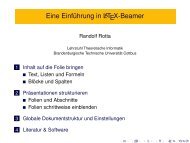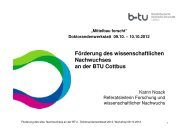Multilevel Graph Clustering with Density-Based Quality Measures
Multilevel Graph Clustering with Density-Based Quality Measures
Multilevel Graph Clustering with Density-Based Quality Measures
Create successful ePaper yourself
Turn your PDF publications into a flip-book with our unique Google optimized e-Paper software.
4.3 Effectiveness of the Merge SelectorsModularity <strong>with</strong> RW ReachabilityRuntime <strong>with</strong> RW Reachability (DIC28_main)mean modularity0.56 0.57 0.58 0.59●● RWreach−sgrd 1RWreach−sgrd 3RWreach−sgrd 5RWreach−none 1RWreach−none 3RWreach−none 5WD−sgrdWD−none●●●time [s]0 200 400 600 800 1000 1200●● RWreach−sgrd 1RWreach−sgrd 3RWreach−sgrd 5RWreach−none 1RWreach−none 3RWreach−none 5●●●1.0 1.5 2.0 2.5 3.0 3.5 4.0length of random walks(a) Modularity <strong>with</strong> Random Walk Reachability1.0 1.5 2.0 2.5 3.0 3.5 4.0length of random walks(b) Runtime <strong>with</strong> Random Walk Reachability onDIC28 mainFigure 4.4: The Random Walk ReachabilityFinally Figure 4.3b compares the runtime on the graph DIC28 main. The values<strong>with</strong> and <strong>with</strong>out refinement are plotted to provide a time scale relative to therefinement costs.The first table and figure show that the random walk distance selector becomesslightly better <strong>with</strong> longer random walks. However the mean modularities are verylow compared to the weight density selector. With refinement RWdist is nearly asgood as weight density is already <strong>with</strong>out any refinement. In fact RWdist foundbetter clusterings just on the two smallest graphs (SouthernWomen and dolphins).At the same time computing this selector is extremely expensive compared to therefinement. Therefore it is removed from the further evaluation.4.3.2 Random Walk ReachabilityThe random walk reachablity modifies the edge weights using short random walks.This modification operator can be applied on its own results and the RW iterationsparameter controls this number of applications. Here the values 1, 3, and 5 areconsidered. Again the parameter RW length defines the length of the random walksand the values 1–4 are used. The combination <strong>with</strong> length one and just one iterationis equal to the original weight density selector. Because iterated application doesnot change the weights the other iteration counts were excluded in this combination.The remaining setup is identical to the previous evaluations and the two algorithmsare named RWreach-sgrd and RWreach-none.Table 4.6 summarizes the mean modularities produced by the 20 configurationson the reduced set of graphs. The columns contain the length of the walks andthe rows the two algorithms RWreach-sgrd and RWreach-none combined <strong>with</strong> the69






